Ancient Trees Race to the Top
Air Date: Week of October 13, 2017
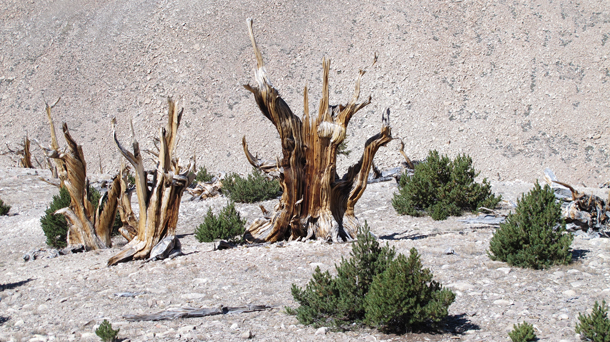
Above, young limber pine trees have taken root next to old, dead bristlecone pines in the White Mountains of California. (Photo: Brian Smithers)
Trees tend to move to higher, cooler habitats in response to a warming climate. Now research on two pine tree species in the western US Great Basin that can live for thousands of years, the bristlecone and limber pines, shows that some species move faster than others. Young limber pines are taking over the higher real estate before their bristlecone cousins get there. Brian Smithers led the research at the University of California, Davis and tells host Steve Curwood this is partly due to the way the trees’ seeds are spread. It could be thousands of years before we really know how human-caused global warming has affected these enduring trees.
Transcript
CURWOOD: Trees are on the move. The warming climate is prompting some species to head up mountainsides to higher, cooler elevations. Of course individual trees can’t pick up their roots and climb, but over time saplings on uphill side tend to do better than their downhill brethren. Over time the species as a whole shifts up. And now new research from the University of California Davis reveals an unexpected wrinkle on this upward trend. It appears the long-lived limber pine is leapfrogging over its cousin the even longer living bristlecone pine in the race to the top.
Brian Smithers led the research at the U.C. Davis. Brian, welcome to Living on Earth.
SMITHERS: Thanks for having me.
CURWOOD: I gather as an avid hiker as well as a scientist you're quite familiar with the bristlecone and limber pines, trees that not only grow but thrive in astonishingly harsh conditions. Please describe them for us them and where they live.

A young limber pine grows close to a stand of larger, older bristlecone pines on Charleston Peak in the Spring Range of southern Nevada. (Photo: Brian Smithers)
SMITHERS: They're found throughout the Great Basin which, you know, is known as being a harsh environment in general, but they're also found in what we call the Sky Islands, these super high mountains throughout the Great Basin which not only have the benefit of being dry but also brutally cold in the winter and then pretty warm in the summer. So, they sort of get the worst of all worlds as far as climatic or weather conditions go. Where they grow in good conditions they actually look like a normal, pretty-looking tree, you know. They look almost like a Christmas tree. But where they grow in rougher conditions, on ridges or a tree line, they just get beaten down by really high winds blowing snow, blowing ice and they take on sort of a representation I think of those conditions – gnarled twisted wood, half the tree dead or dying, but just continuing to push through. That's kind of the amazing thing about them is their ability to survive these crazy conditions and their ability then to sort of take on the shape of really rough conditions.
CURWOOD: And these trees can be, well, they can get to be quite old, I gather.
SMITHERS: Yeah, depending on what you call an individual and there's some debate about that, but as far as individual organisms go on Earth, there's nothing older. The oldest known tree is one we call Methuselah. It's a little over 5,000 years old.
CURWOOD: Now, your study is about what you call a leapfrogging effect. There’s one species of tree, the limber pine which I guess only lives about 2,000 years as opposed to 5,000 years, a little youngster there; whereas, the bristlecone pine can live 5,000 years, and they are sort of in a race to the top. As things get warmer and warmer these trees seem to want to move up higher and higher. Why are you studying these trees?
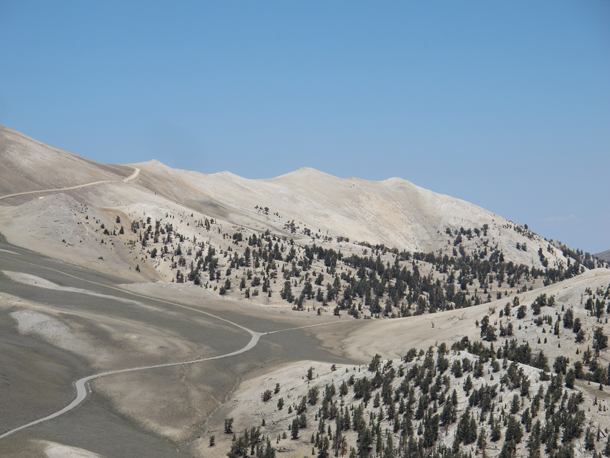
Treeline in the White Mountains. The older trees are mostly bristlecone pine, but younger limber pines now dot the landscape just above the old treeline. (Photo: Brian Smithers)
SMITHERS: The reason we're looking at this, first of all, we wanted to look at how species, how trees in particular are responding to climate change, tree line is a really nice experimental spot to do that because it's a real clear line of a species range edge, a species range margin, because it's controlled almost exclusively by temperature. And so when we want to see, OK how are species responding to climate change, we ought to expect tree line to be moving up slope, and in fact it is. There are lots of studies all over the world where it is. There some where tree lines are not moving up, but in the Great Basin we could see it on the landscape, but it didn't look like we thought it ought to look, just by walking around. bristlecone pine, adults, dominate typical tree line stands in most of the Great Basin, and you are hard pressed to find limber pine adults in those forests right at tree line. And yet the vast majority of the trees establishing above that tree line turned out to be this limber pine which is typically found further down slope of bristlecone pine.
So, somehow it appears that the seeds are dispersing from well down slope to above tree line, that's the leap frog effect, and establishing quite a bit faster than bristlecone pine is, and so you're getting this interesting sort of down slope band of limber pine, then a band of bristlecone pine, and then another band upslope of limber pine.
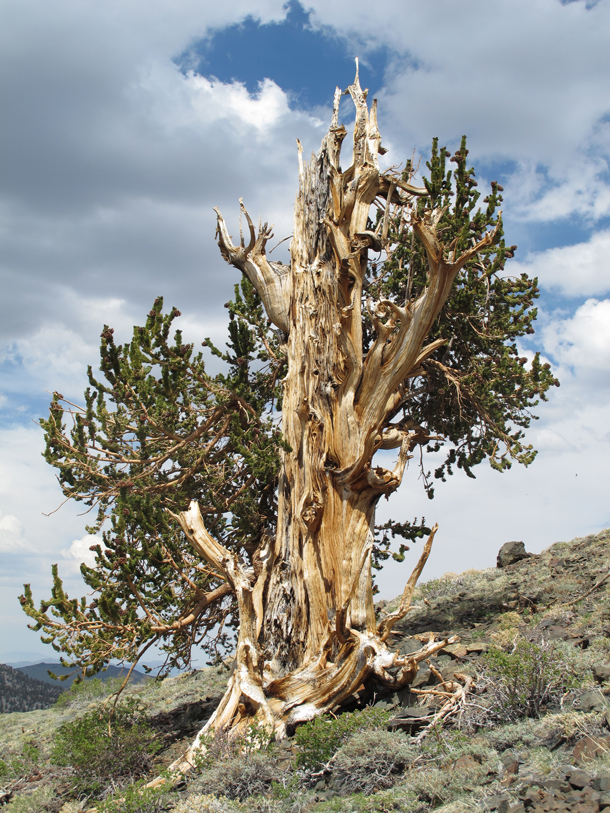
With a lifespan of at least 5,000 years, bristlecone pine trees are believed to be the oldest individual living plants on Earth. (Photo: Brian Smithers)
CURWOOD: So, in this race to respond to climate change, the limber pines are going faster, although something that lives for a couple of thousand years, I'm not sure that “fast” is exactly the right word.
SMITHERS: [LAUGHS:] Less slow maybe? Yes, they are moving faster, and I think even when we think in terms of 2,000 years, 5,000 years, we're talking about an effect that's happened in the last 50 years, and that's pretty fast. You know the individual trees for limber pine can live 2,000 years, for bristlecone pine can live 5,000 years, but a young tree can move about the landscape and responds to changing climate pretty quickly and, in fact, that's what we're seeing. And so this process does appear to be happening pretty quickly, certainly relative to the ages of these species.
CURWOOD: How much is the climate changing in the bristlecone pine, limber pine territory?
SMITHERS: We do have documented evidence of climate change. We've seen a little bit more than one degree Celsius average increase in temperature over the last 100 years based on these climate reconstructions, and so it's warmer, it's definitely warmer. We know that must have impacts on snow, the amount of time that the snow is on the landscape, maybe even how much snow is on the landscape, and that snow is a really important thermal barrier during the winter. It actually keeps the trees a little bit warmer, having that snow because it's much colder than freezing in these mountains typically during the winter.
CURWOOD: So, these trees can both survive in the same climate, right? So why are the limber pines moving ahead?
SMITHERS: Yeah, they survive in more or less in the same climate. Bristlecone pine can handle a little colder, limber pine maybe a little warmer, a little drier. We think they're moving ahead because they've got a dispersal advantage, and what that advantage is, there's this bird called the Clark's nutcracker which prefers the large nutritious seeds of limber pine to bristlecone pine. Bristlecone pine seeds are pretty small and they are winged. They're adapted to just be dispersed by gravity and a little bit of wind. But limber pine, the cones don't even open up on their own until much later mostly the cones get picked apart by this bird called the Clark's nutcracker, which harvests the seeds and they cache individually tens of thousands of these seeds per year all across the landscape.
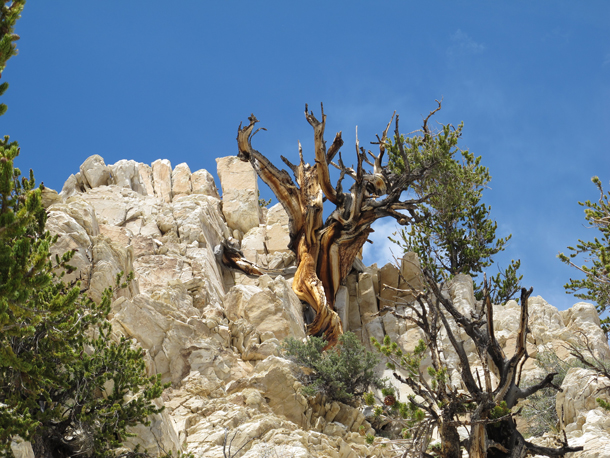
Bristlecone pines sometimes appear to be growing straight out of the rocks. (Photo: Brian Smithers)
Studies show that they can travel up to five miles in any direction which really gets them out of all over the place and so they're caching these seeds all over some of which they eat over the winter but a lot of them they don't get to, and so those seeds get buried at an optimal depth for germination. They get hidden from seed predators. They get just a real clear advantage over bristlecone pine and when we've got this really great - You know, I sort of liken it to a real estate boom above tree line - it's really a large area that's now available, climatically available, and the first one there can really define what that forest is going to look like going forward.
CURWOOD: Brian, I'm confused about one thing there. Why are the limber pines a lot less common with the bristlecones right now if they can both survive in basically the same climate and the limber has a more efficient way of getting their seeds distributed? Why did the bristlecone have such a hold on the basic tree line?
SMITHERS: That's a really good question. I'm afraid I don't have a great answer for that because we won't know the results of the phenomenon we're seeing now for 5,000, 10,000 years.
I've got a couple of theories on that. The first one is that for these trees, for this species, they're still sort of coming out of a really cold period we call the Little Ice Age that was sort of wrapping up around 1850, and during that time there was no regeneration at all in these sub-Alpine forests. It was just too cold, and it's likely that during that time period, if there were limber pine around, it probably got too cold for them during that period, and they died out. And so, maybe what we're seeing is some combination of these high mountain sort of, still kind of slowly coming out of this Little Ice Age coupled with human-induced climate change, global warming, allowing limber pines to move back into these systems.
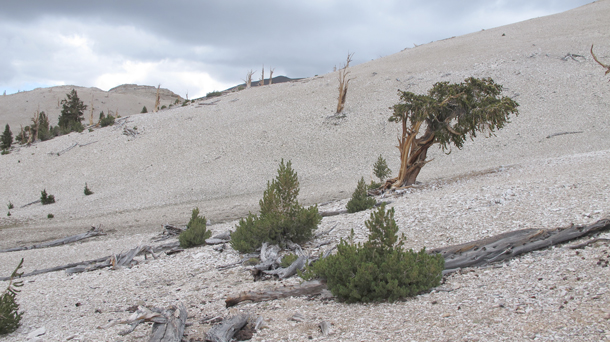
Above, a single, large bristlecone pine is surrounded by much smaller, younger limber pines in the White Mountains. (Photo: Brian Smithers)
That's one theory. The other theory is that over the long haul bristlecone pine is just a stronger competitor and that would mean they've been able to exclude limber pine, and those two theories are really at odds going forward. It means that if it's "A," you know, if it's climate, we can expect that limber pine would stick around in these newly established forests. If it's "B", if it's bristlecone pine is a stronger competitor, maybe limber pine gets in there now but over the long haul, 10,000, 20,000, 30,000 years, we'd expect bristlecone pine to ultimately replace limber pine and their march up slope in response to climate change.
CURWOOD: Brian, tell me, how important are the bristlecone pines and the limber pines to their ecosystem, especially places where the dominant? I'm thinking of the White Mountains, there, in California.
SMITHERS: Right, both species really are, are a foundation species in these forests. Without either one of them you're looking at a sagebrush scrub or alpine environment, and the difference between a shrubland and a forest or an alpine environment and a forest are night and day, those are very different systems, and so you know these forests bring with them a lot of species, and they contribute substantially to the diversity of the White Mountains. There are forest bird communities that are there that certainly provides refuge for larger game, things like black-tailed deer. So, these forests are really important.Whether there is a substantial difference between bristlecone and limber pine as far as their ability to create that ecosystem, yeah, I don't know that there is a huge difference.
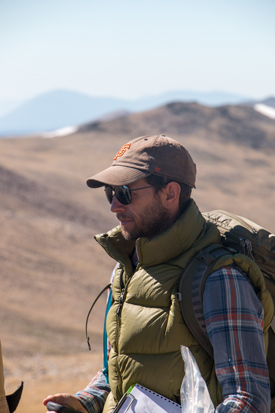
Brian Smithers, seen here doing research in the field, in 2017 was finishing up a Ph.D. program in ecology at the University of California, Davis. (Photo: Marc Hoshovsky)
CURWOOD: Now, you said that perhaps the oldest tree is named, Methuselah, the oldest bristlecone. What's your favorite bristlecone pine, and does it have a name?
SMITHERS: Oh, that's a good one. My favorite bristlecone pine is off the beaten track. There's a naturalist of great fame in the White Mountains. His name is Tim Forcell, and he's been running around those mountains for 20, 30 years, long time, and he took me to this place called the Boulevard of the Giants, which is basically unknown I think to most people. He gave it that name. It's just full of these very large, very old trees with just the most beautiful forms imaginable. There's one particular tree in that grove that - It defies explanation truly but it's just a phenomenally beautiful tree and it's clear it's seen a lot of days, some good, some not so good evidently.
CURWOOD: So, it's on the gnarled side or it's on the very tall and proud side?
SMITHERS: It's on the gnarled side. I think I tend to appreciate generally things that sort of, they get by. They live on the edge, and I think that's what drew me to these forests in these Bristlecone pines to begin with because their ability to withstand takes a toll on them, but they do it.
CURWOOD: Brian Smithers is just about all done with his PhD from the University of California Davis. Thanks so much for taking the time with us today.
SMITHERS: Thank you. It was really my pleasure.
Links
Los Angeles Times: “Ancient bristlecone pine forests are being overwhelmed by climate change”
Living on Earth wants to hear from you!
Living on Earth
62 Calef Highway, Suite 212
Lee, NH 03861
Telephone: 617-287-4121
E-mail: comments@loe.org
Newsletter [Click here]
Donate to Living on Earth!
Living on Earth is an independent media program and relies entirely on contributions from listeners and institutions supporting public service. Please donate now to preserve an independent environmental voice.
NewsletterLiving on Earth offers a weekly delivery of the show's rundown to your mailbox. Sign up for our newsletter today!
 Sailors For The Sea: Be the change you want to sea.
Sailors For The Sea: Be the change you want to sea.
 The Grantham Foundation for the Protection of the Environment: Committed to protecting and improving the health of the global environment.
The Grantham Foundation for the Protection of the Environment: Committed to protecting and improving the health of the global environment.
 Contribute to Living on Earth and receive, as our gift to you, an archival print of one of Mark Seth Lender's extraordinary wildlife photographs. Follow the link to see Mark's current collection of photographs.
Contribute to Living on Earth and receive, as our gift to you, an archival print of one of Mark Seth Lender's extraordinary wildlife photographs. Follow the link to see Mark's current collection of photographs.
 Buy a signed copy of Mark Seth Lender's book Smeagull the Seagull & support Living on Earth
Buy a signed copy of Mark Seth Lender's book Smeagull the Seagull & support Living on Earth

